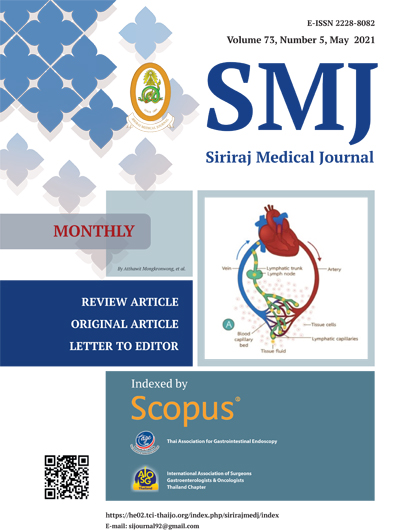Comparison of the Sensitivity and Specificity of Tzanck Smear and Immunofluorescence Assay for the Diagnosis of Cutaneous Herpes Simplex Virus and Varicella Zoster Virus Infections in a Real-life Clinical Setting
DOI:
https://doi.org/10.33192/Smj.2021.40Keywords:
Herpes simplex virus, varicella zoster virus, Tzanck smear, immunofluorescenceAbstract
Objective: This research aim to compare (1) the sensitivities and specificities of Tzanck smears and indirect immunofluorescence assays (IFA) for cutaneous HSV and VZV infections in real-life settings; and (2) the detection rates of the tests for various patient types and lesion morphologies.
Materials and Methods: This retrospective study reviewed 440 and 172 samples from patients with clinically suspicious cutaneous HSV and VZV infections, respectively. All patients underwent a Tzanck smear and IFA. The gold standard for the study was agreement of pre- and post-diagnostic coding (determined by a dermatologist) for cutaneous HSV and VZV infections.
Results: For HSV infections, the respective sensitivity and specificity of Tzanck smears were 32.8% and 96.6%, whereas those for IFA were 60.7% and 100%. As to VZV infections, the sensitivity and specificity of Tzanck smears were 54.3% and 97.8%, respectively, while the corresponding IFA values were 71.7% and 100%. According to disease characteristics and lesion morphologies, the detection ability of cutaneous HSV by IFA was substantially higher than Tzanck smear especially in immunosuppressed condition. Tzanck smears and IFA demonstrated no statistical difference for early-onset ( 3 days) VZV infections.
Conclusion: Tzanck smears and IFA had higher sensitivities for detecting VZV than HSV infections. IFA testing in suspected cutaneous HSV patients with immunosuppressed conditions should be recommended. Despite the overall sensitivity and specificity of IFA being greater than those for Tzanck smears especially in HSV infections, the latter test is a comparable option for early-onset VZV infections.
Published
How to Cite
Issue
Section
License
Copyright (c) 2021 Siriraj Medical Journal

This work is licensed under a Creative Commons Attribution-NonCommercial-NoDerivatives 4.0 International License.
Authors who publish with this journal agree to the following conditions:
Copyright Transfer
In submitting a manuscript, the authors acknowledge that the work will become the copyrighted property of Siriraj Medical Journal upon publication.
License
Articles are licensed under a Creative Commons Attribution-NonCommercial-NoDerivatives 4.0 International License (CC BY-NC-ND 4.0). This license allows for the sharing of the work for non-commercial purposes with proper attribution to the authors and the journal. However, it does not permit modifications or the creation of derivative works.
Sharing and Access
Authors are encouraged to share their article on their personal or institutional websites and through other non-commercial platforms. Doing so can increase readership and citations.















